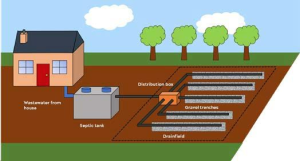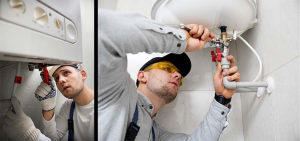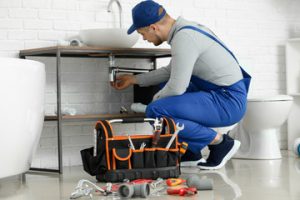A septic tank provides the first stage of wastewater treatment before it leaves your home. Wastewater flows from your interior plumbing into the septic tank to break down organic solids and bacteria that contaminate the environment.
Patent CN217351134U displays an innovative design that utilises concrete pipe to create a multi-chamber system. The system features a separate aerobic, anaerobic and clarifying chamber that offers enhanced wastewater treatment. Click here to Learn More.

A septic tank uses natural and proven processes to treat the wastewater from your toilets, kitchen drains, laundry, and other household plumbing. It is a buried, water-tight container made of concrete or polyethylene.
Wastewater from your toilets, showers, sinks, and dishwasher flows through a main drainage pipe into the septic tank. Solid materials from these plumbing fixtures—including sludge, grease, and oil—sink to the bottom of the septic tank and undergo bacterial digestion to break them down into liquids.
Liquid wastewater, or effluent, exits the septic tank through an outlet baffle into the septic system’s drain field. The soil in the drain field—also known as an absorption field or leach field—filters and treats the wastewater as it seeps into underground aquifers.
The septic tank removes most of the organic wastewater pollutants, but not all of them. If a home’s septic tank is too small, solids may overflow from the tank into the drain field and cause it to become clogged. Overloaded septic tanks may also flood the drain field and expose humans and animals to disease-causing bacteria from the sewage.
Each septic tank contains multiple compartments separated by partial walls. As the wastewater flows into the septic tank, the solids settle in the bottom chamber and liquids move over the half wall into the larger compartment. A healthy population of anaerobic bacteria in the lower chamber digests the organic waste. The septic tank’s half-walls and outlet baffle prevent sludge and scum from leaving the septic tank and entering the drainfield area.
When the septic tank is full, the float switch on the inlet valve activates and signals the automatic float-and-boiler to close the outlet. This prevents sludge and scum from flowing into the drainfield area where they could contaminate groundwater.
As the wastewater trickles through a series of perforated pipes in the drain field, it seeps into the soil and dissolves slowly into underground aquifers. In the process, it passes through rocks and sand to filter out impurities and nutrients. The soil acts as a natural organism-rich filter and naturally purifies the water as it passes through.
Benefits
Using a septic tank offers several advantages, including not having to pay for municipal sewer costs. It also provides a more environmentally friendly method of waste disposal. However, it is important to have your septic tank serviced regularly. When the septic system is functioning properly, it can help prevent groundwater contamination by disposing of sewage waste into the soil rather than directly in the water supply. A septic tank can also reduce the number of parasites that are found in drinking water.
A septic tank is not as effective as a sewage treatment plant at breaking down solid waste, but it does provide some basic biological treatment. Bacteria that live inside the tank digest some of the sludge and scum layers, and they keep those materials from flowing to the drain field.
The septic tank is linked to the drain field through a pipe that is buried underground. The liquid waste flows out of the septic tank, and it percolates through the ground into the leach field or absorption field. This field acts as a natural filter to remove disease-causing organisms from the wastewater before it reaches surface water and soil.
As the septic tank fills, heavy solids sink to the bottom and form the sludge layer. Lighter materials such as grease float to the top and form the scum layer. A baffle wall separates the sludge and scum so that only sewage liquid leaves the septic tank to flow into the leach field.
The solids from the septic tank are slowly broken down by bacteria and other microorganisms as they enter the leach field. This process takes a long time, and it is necessary to have the tank pumped out periodically so that solids do not build up.
Chemicals such as detergents, toilet fresheners, fabric conditioners and heavy cleaners can upset the delicate balance of bacteria in a septic tank and cause it to overflow or clog. Mindful water usage can avoid this problem by reducing the amount of liquid that goes down the drains. It is also helpful to keep trees and shrubs away from the drain field to prevent root damage.
Disadvantages
Septic systems are often used in rural areas where the cost of hooking into municipal sewers would be prohibitive. However, they are not ideal in densely populated suburban or urban areas because they can be susceptible to overloading and blockages. Also, septic systems are not good for homes with well water since groundwater contamination is possible. If you are considering moving to a rural area, be sure to check if the house has a septic tank before buying it.
A septic system is a complex underground waste treatment structure that separates wastewater into three layers. The liquid layer, known as scum, rises to the surface and the solids sink to the bottom of the tank where they are slowly dispersed into the surrounding soil in the drainfield. The solids that have been pumped out of the tank are buried in the drainfield and treated further by microbes, which break them down into harmless organic matter.
The septic tank must be inspected and maintained to prevent clogs. A septic tank that is not properly inspected and maintained can overflow, which can be dangerous to human beings and animals. The septic tank can also become a breeding ground for mosquitoes and other pests.
If you are not accustomed to living with a septic tank, you will need to adjust your everyday habits. For example, it is important to only flush toilet paper and human waste. Non-biodegradable materials like kitty litter, cigarette butts and grease should not be sent down the drain. Likewise, do not use too much soap or shampoo. These can cause the septic system to work overtime, leading to a clog or an overflow.
You will also need to mow the lawn above the septic system and keep the drain field free of trees, bushes and other plants with roots that could clog the pipes. Finally, do not park any vehicles on the septic tank or drain field. The weight of the vehicle could slam into the tank, causing it to crack or leak.
It is essential to get the septic tank pumped every few years to prevent clogs and overflows. The average cost is $300 – $600, which can be cheaper than municipal sewer costs.
Maintenance
A septic tank is an essential part of your home’s wastewater management. As with any system, it requires regular upkeep to function correctly. This maintenance includes routine inspections by a septic tank professional to catch any potential issues before they become more serious. It also involves regularly pumping the tank based on its size and waste volume, as well as filter replacements and other repairs.
As sewage flows from your plumbing connections into the septic tank, the weighty masses sink to the bottom and undergo bacterial action that transforms them into digested slime and vapor. Lighter masses, including grease and oils, ascend to the top of the septic tank where they form a layer of scum. This scum is removed regularly by the septic tank’s pump. Typically, the septic tank will need to be pumped when the sludge layer is within 6 inches of the outlet and/or when 25% or more of the liquid depth is made up of sludge and scum.
A key aspect of septic tank maintenance is avoiding flushing things that can clog the drain field, including paper towels, non-flushable wipes (such as baby or makeup removal), cat litter, cigarette butts, pharmaceuticals and even latex paint. In addition, homeowners should mow the grass above the septic tank and drain field and keep it clear of trees and shrubs whose roots can clog the drainage area.
When you’re ready to have your septic tank inspected and pumped, it’s important that you hire a septic tank professional who is experienced and certified to perform these services. They should have experience with a wide variety of septic systems and will be able to identify any problems quickly and effectively.
By prioritizing regular septic tank maintenance, homeowners can significantly reduce the risk of costly septic system repairs and environmental concerns. In fact, neglecting septic tank maintenance is akin to driving your car without oil! By making routine inspections, cleanings and pumping a priority, you can enjoy the benefits of a healthy septic tank for the long term. Contact Mathis and Sons Septic today to schedule your next septic tank maintenance appointment.


